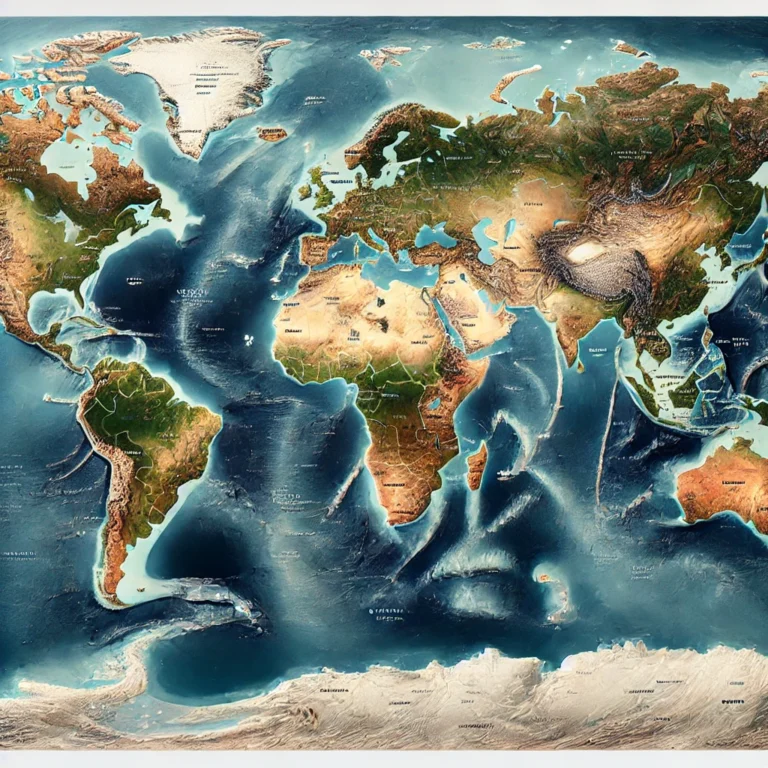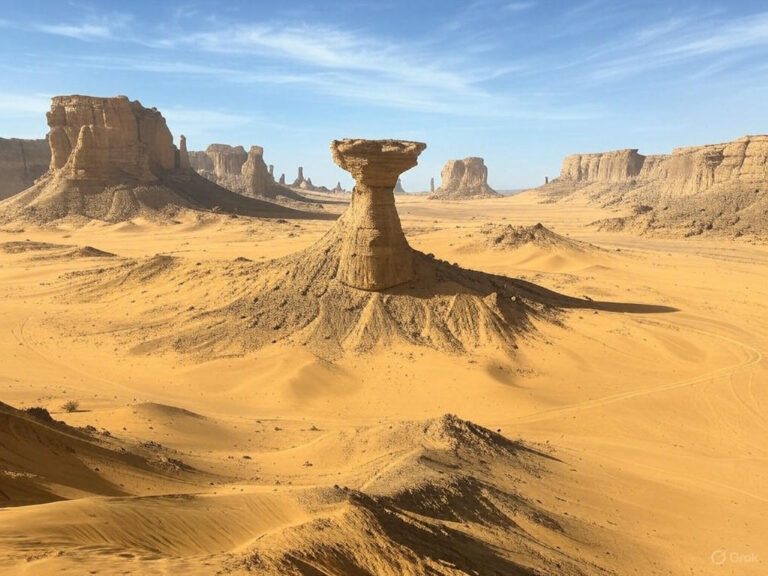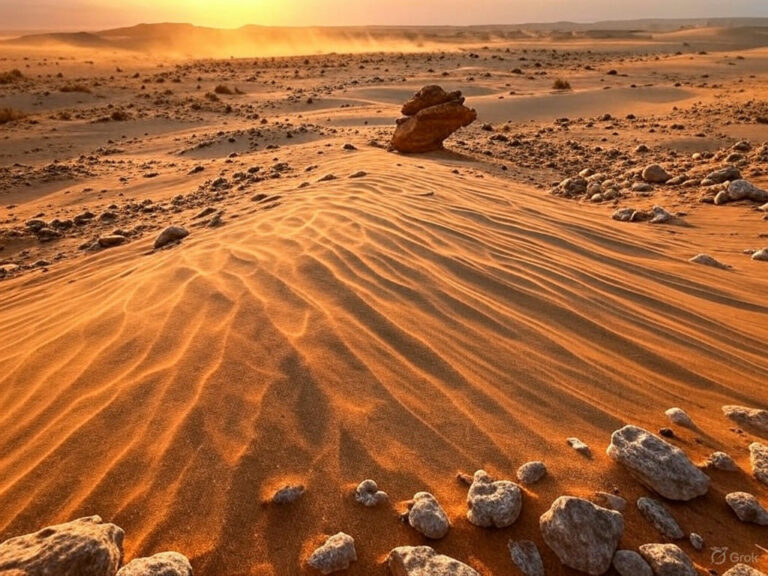Igneous Rocks UPSC
Imagine you are standing near a volcano, watching molten lava flow out of the Earth. This fiery liquid is magma when it is beneath the surface and lava when it reaches the surface. But what happens when this molten material cools and solidifies? It turns into igneous rocks, also known as primary rocks, because they are the first type of rocks to form on Earth. Let me take you on a journey to explore their characteristics, and types.
Characteristics of Igneous Rocks
- Hard and Impermeable: Water cannot easily pass through them.
- Why igneous rocks typically hard: Picture snow and ice: snow forms when water vapor cools directly into soft flakes, while ice forms from liquid water, making it hard and solid. Similarly, igneous rocks are typically hard because they form from liquid magma or lava.
- Granular or Crystalline: Depending on the cooling rate, they can have large, small, or no visible crystals.
- Non-Stratified: Unlike sedimentary rocks, they do not form layers or strata.
- Resistant to Chemical Weathering: Most igneous rocks, except basalt, withstand chemical breakdown.
- No Fossils: Being born in fire, they contain no traces of past life.
Examples include granite, gabbro, pegmatite, and basalt.
Classification of Igneous Rocks
- On the basis of Composition
- Felsic Rocks
- Intermediate Rocks
- Mafic Rocks
- Ultramafic Rocks
- On the basis of Texture of Crystals
- Pegmatitic rocks
- Phaneritic rocks
- Aphanitic rocks
- Glassy rocks
- Porphyritic rocks
- On the basis of Mode of Occurrence
- Intrusive Igneous Rocks
- Plutonic Rocks
- Hypabyssal Rocks
- Batholiths
- Laccoliths
- Phacoliths
- Lopoliths
- Sills
- Dykes
- Extrusive Igneous Rocks
- Explosive Type
- Quiet Type
- Intrusive Igneous Rocks

1. Based on Composition: What’s Inside These Rocks?
Igneous rocks are classified into four major categories based on their composition, particularly their silica (SiO₂) content, color, weight, and the depth of their formation. The key categories are Felsic, Intermediate, Mafic, and Ultramafic rocks. Here’s an in-depth look:
A. Felsic Rocks
- Definition: These rocks are rich in silica, light in color, and low in density.
- Composition:
- Silica content: 65–76% (very high).
- High in lighter elements like potassium, sodium, and aluminum.
- Low in heavy elements like iron and magnesium.
- Characteristics:
- Acidic in nature: High silica makes the magma more viscous (thick and sticky).
- Lighter in weight due to their composition.
- Light in color: Colors are generally white, pink, or light gray.
- Crystalline structure: Often have visible, large crystals due to slower cooling of magma.
- Examples: Granite is the most common felsic rock. It forms continental crust and is extensively used in construction.
B. Intermediate Rocks
- Definition: These rocks are transitional between felsic and mafic rocks, both in composition and properties.
- Composition:
- Silica content: 55–65% (moderate).
- Contain a balanced mixture of lighter (feldspar) and heavier (iron and magnesium) minerals.
- Characteristics:
- Moderately acidic: Less viscous magma than felsic but more than mafic.
- Lighter in weight and colour compared to mafic rocks.
- Colour: Greyish or light-coloured, though slightly darker than felsic rocks.
- Examples: Andesite is a common intermediate rock. It often forms at convergent plate boundaries.
C. Mafic Rocks
- Definition: These are basic igneous rocks, rich in heavier minerals and darker in color.
- Composition:
- Silica content: 45–55% (low).
- High in iron (Fe) and magnesium (Mg).
- Characteristics:
- Basic in nature: Low silica makes magma less viscous, allowing it to flow easily.
- Heavier: Due to the presence of denser minerals like pyroxenes and olivine.
- Darker in color: Typically black, dark green, or dark gray.
- Examples: Basalt is the most common mafic rock. It forms the oceanic crust and is frequently seen in volcanic eruptions
D. Ultramafic Rocks
- Definition: These rocks are extremely low in silica and are composed almost entirely of heavy minerals.
- Composition:
- Silica content: <40% (very low).
- Exceptionally high in iron (Fe) and magnesium (Mg).
- Characteristics:
- Basic and heavier: Due to the dominance of dense minerals.
- Darker in color: Often dark green or black.
- Form deep in the Earth’s mantle under high pressure and temperature.
- Examples: Peridotite is the typical ultramafic rock. It constitutes much of the mantle.
Depth-Based Transition in Rocks
- As we go deeper into the Earth, rocks become:
- Darker in color: Due to higher iron and magnesium content.
- More basic: Silica content decreases as depth increases.
- Heavier in weight: Increased concentration of dense minerals.
- As we move towards the surface, rocks become:
- Lighter in color: Higher silica and lighter elements like potassium dominate.
- More acidic: Silica content increases.
- Lighter in weight: Minerals are less dense.
Visual Summary
| Rock Type | Silica Content | Color | Weight | Example |
|---|---|---|---|---|
| Felsic Rocks | 65–76% | Light (white, pink) | Light | Granite |
| Intermediate | 55–65% | Light gray | Moderate | Andesite |
| Mafic Rocks | 45–55% | Dark (black) | Heavy | Basalt |
| Ultramafic | <40% | Very dark | Very heavy | Peridotite |
2. Based on Texture: How Do They Look?
The texture of igneous rocks is determined by the size, arrangement, and appearance of their crystals. These characteristics reflect the cooling rate and environment of magma or lava during solidification. Based on texture, igneous rocks can be classified into five main types: Pegmatitic, Phaneritic, Aphanitic, Glassy, and Porphyritic.
A. Pegmatitic Rocks
- Definition: Rocks with extremely large crystals, often greater than 1 cm in size.
- Formation:
- Formed from very slow cooling magma deep below the Earth’s surface.
- Often associated with high water content in magma, which enhances crystal growth.
- Characteristics:
- Crystals are so large that individual minerals are easily identifiable with the naked eye.
- Texture is coarse-grained and uneven.
- Typically found in pegmatites, which are veins or pockets of crystallized magma.
- Examples: Pegmatitic granite is a common example, often containing rare minerals like tourmaline or beryl.
B. Phaneritic Rocks
- Definition: Rocks with large, visible crystals ranging from 1 mm to a few centimeters in size.
- Formation:
- Formed from slow cooling magma at depths within the Earth’s crust.
- This allows sufficient time for crystals to grow to a size visible to the naked eye.
- Characteristics:
- Texture is coarse-grained, but not as extreme as pegmatitic rocks.
- Crystals are tightly interlocked.
- Found in intrusive igneous rocks.
- Examples: Granite and gabbro are typical phaneritic rocks.
C. Aphanitic Rocks
- Definition: Rocks with crystals so small they are not visible to the naked eye (less than 1 mm).
- Formation:
- Formed from rapid cooling magma or lava, typically on or near the Earth’s surface (extrusive environment).
- Fast cooling prevents the growth of large crystals.
- Characteristics:
- Texture is fine-grained, often giving the rock a uniform appearance.
- Commonly found in volcanic rocks.
- Examples: Basalt and rhyolite are common aphanitic rocks.
D. Glassy Rocks
- Definition: Rocks with no crystals, appearing as smooth glass-like solids.
- Formation:
- Formed from extremely rapid cooling lava, where crystals do not have time to form.
- Typically associated with volcanic eruptions and quenching (cooling in water or air).
- Characteristics:
- Texture is non-crystalline, smooth, and shiny.
- May have conchoidal (curved) fractures.
- Composition is predominantly silica.
- Examples: Obsidian is the most well-known glassy rock.
E. Porphyritic Rocks
- Definition: Rocks with a mixed texture, containing both large crystals (phenocrysts) and fine grains (groundmass).
- Formation:
- Formed in a two-stage cooling process:
- Slow cooling of magma deep underground forms large crystals.
- Rapid cooling as magma rises to the surface forms the fine-grained groundmass.
- Characteristics:
- Texture is a mix of coarse-grained and fine-grained components.
- Phenocrysts are scattered within the finer matrix.
- Indicates a complex cooling history.
- Examples: Porphyritic andesite and porphyritic basalt are common examples.
Key Insights: Relationship Between Texture and Formation
| Type of Rock | Crystal Size | Cooling Rate | Environment | Example |
| Pegmatitic Rocks | Very large (>1 cm) | Very slow | Deep intrusive veins | Pegmatitic granite |
| Phaneritic Rocks | Large (1 mm–several cm) | Slow | Intrusive | Granite, Gabbro |
| Aphanitic Rocks | Fine (<1 mm) | Rapid | Extrusive | Basalt, Rhyolite |
| Glassy Rocks | No crystals (amorphous) | Extremely rapid | Volcanic | Obsidian |
| Porphyritic Rocks | Mixed (large + fine) | Complex (slow + rapid) | Transition (intrusive + extrusive) | Porphyritic andesite |
Conclusion
The texture of igneous rocks is a crucial indicator of their cooling history and formation environment. Rocks with large crystals form deep underground, where cooling is slow, while fine-grained or glassy textures reflect rapid cooling at or near the surface. Porphyritic textures, on the other hand, represent a combination of both slow and rapid cooling, highlighting their transitional formation history
3. Based on Mode of Occurrence: Where Do They Form?
Igneous rocks are classified into two categories based on where and how magma or lava cools and solidifies: Intrusive Igneous Rocks (formed below the Earth’s surface) and Extrusive Igneous Rocks (formed at the surface). Each category has unique types and features, determined by the mode of magma emplacement.
1. Intrusive Igneous Rocks
These rocks form when magma does not reach the surface and cools slowly beneath the Earth’s crust. The slow cooling allows large crystals to form. Intrusive igneous rocks are further divided into two types:
a. Plutonic Rocks
- Formation:
- Form deep inside the Earth’s crust.
- Due to the very slow cooling process, large and coarse grains develop.
- Characteristics:
- Crystals are easily visible due to their size.
- Rocks are often hard and durable.
- Example: Granite.
b. Hypabyssal Rocks
These rocks form when magma cools and solidifies just beneath the Earth’s surface, at shallower depths compared to plutonic rocks. They are classified into various forms based on the shape and structure of the solidified magma:
- Batholiths:
- Large, irregular, undulating bodies of solidified magma.
- Characteristics:
- Usually dome-shaped.
- Exposed parts are known as cratons or shields, which are rich in minerals.
- Typically form the cores of mountain ranges.
- Example: Batholiths in the Himalayas.
- Laccoliths:
- Mushroom-shaped intrusions with a convex summit.
- Formation:
- Ascending magma forces sedimentary layers above it to arch upward, forming a dome.
- Example: Found in the Black Hills of South Dakota.
- Phacoliths:
- Formed when magma is injected along the crests of anticlines or the troughs of synclines in folded mountain regions.
- They align with the natural folds of rock layers.
- Lopoliths:
- Concave, shallow, basin-shaped intrusions where the central part sags downward as magma solidifies.
- These are rare formations.
- Sills:
- Horizontal sheet-like intrusions of magma between layers of pre-existing rock.
- Form parallel to the bedding planes.
- Dykes:
- Vertical or wall-like intrusions of magma that cut across existing rock layers.
- Often form networks of crisscrossing solidified magma.


2. Extrusive Igneous Rocks
Extrusive rocks form when magma reaches the Earth’s surface, where it cools and solidifies rapidly. This results in fine-grained or glassy textures. Extrusive igneous rocks are categorized into:
a. Explosive Type
- Formation:
- Occurs when volcanic materials are violently ejected during explosive eruptions.
- Volcanic Materials:
- Volcanic bombs: Large fragments of magma that solidify as they are ejected.
- Lapilli: Small fragments of solidified lava or tephra.
- Volcanic dust and ashes: Fine particles of fragmented magma.
- Special Feature:
- When these materials are deposited underwater, they form tuffs.
- Example: Volcanic ash deposits around Mount Vesuvius.
b. Quiet Type
- Formation:
- Lava flows out through minor cracks or fissures, spreading across large areas in successive layers.
- Features:
- Forms lava plateaus or lava plains.
- Examples include the Deccan Traps in India and the Columbia River Plateau in the USA.
Key Insights:
- Intrusive rocks form beneath the surface and generally have large crystals due to slow cooling.
- Extrusive rocks form on the surface, cooling rapidly and resulting in fine-grained or glassy textures.
- The transition from plutonic to hypabyssal rocks shows decreasing depth of formation, while the explosive and quiet types of extrusive rocks reflect differences in volcanic activity.
Summary Table:
| Category | Type | Formation Depth | Examples | Key Features |
| Intrusive Rocks | Plutonic | Very deep | Granite | Coarse-grained, large crystals. |
| Hypabyssal | Shallow depths | Batholiths, Laccoliths, etc. | Varied forms of solidified magma. | |
| Extrusive Rocks | Explosive | Surface | Tuffs, volcanic ash | Fragmented materials from violent eruptions. |
| Quiet | Surface | Lava plateaus (Deccan Traps) | Successive layers of lava flow. |
This classification emphasizes the role of cooling rates, depth, and magma behavior in shaping the texture and structure of igneous rocks.
Following diagram you can draw in exams to better articulate your answers:



Igneous Rocks and Landforms: How They Shape Our Planet
Landforms associated with igneous activity are shaped by the intrusion of magma and subsequent erosional processes. These landforms emerge when magma solidifies into resistant rock structures within sedimentary layers or at the surface. Over time, erosion exposes and sculpts these formations.
1. Cuestas and Hogbacks (From Intruded Sills)
- Formation Process:
- When magma intrudes into tilted or inclined sedimentary layers, it cools and solidifies into sills (horizontal, sheet-like intrusions).
- If these sills are more resistant to weathering and erosion than the surrounding sedimentary rocks, they remain as elevated features.
- Key Features:
- Cuestas:
- Form when the inclined layers have a gently dipping slope on one side and a steeper slope on the other.
- The gentle upper slope is known as the dip slope.
- Example: Door Peninsula.
- Hogbacks:
- Form where the sedimentary layers are steeply tilted, creating a sharp ridge with a steep slope.
- Composed of hard rock projecting above softer eroded layers.
- Cuestas:
2. Mesas and Buttes (Erosion of Basaltic Cap Rocks)
- Formation Process:
- Basaltic lava flows form layers of hard, resistant rock at the surface, creating a “cap rock.”
- Over time, erosion removes the softer, underlying rocks, leaving behind isolated, flat-topped landforms.
- Key Features:
- Mesas:
- Large, flat-topped hills or plateaus with steep sides.
- Formed from extensive erosion of surrounding material, leaving behind the resistant cap rock.
- Example: Found in the Colorado Plateau in the USA.
- Buttes:
- Smaller, isolated flat-topped hills with steeper slopes than mesas.
- Represent a further stage of erosion from a mesa.
- Example: Monument Valley in Arizona, USA.
- Mesas:
Summary
- Cuestas and Hogbacks form when resistant igneous sills project above the surface in inclined sedimentary layers, with variations in slope depending on the angle of tilting.
- Mesas and Buttes emerge from the erosion of basaltic lava cap rocks, with mesas being larger and buttes smaller.
- These landforms highlight the interplay between igneous activity and erosional forces, showcasing the dynamic processes shaping the Earth’s surface.


Closing Visualization
Imagine holding a piece of granite in one hand and basalt in the other. One is coarse, light-colored, and formed deep underground, while the other is dark, fine-grained, and born of fiery lava flows. Together, they remind us of the dynamic processes that shape our planet—processes as old as Earth itself.






3 Comments